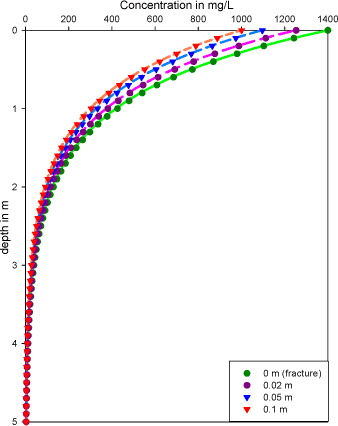Model assessment of reductive dechlorination as a remediation technology for contaminant sources in fractured clay: Modeling tool
Appendix F Model verification – analytical solution
The numerical model is verified by comparing results to an analytical solution for a system of parallel fractures [Sudicky and Frind, 1982]. This analytical solution is also used in SprækkeJAGG [SprakkeJAGG, 2008] and gives the exact solution for concentration in the fracture and matrix at steady-state with a constant concentration at the fracture inlet. In this model, the transport in the matrix is assumed to be one-dimensional in the direction perpendicular to the matrix. Furthermore the degradation rate is assumed to be a 1st order. The parameters used in this verification are listed in Table F.1.
Table F.1 - Parameters used for the model verification
| Parameters | Symbol | Value | Unit |
| Net recharge | I | 0.1 | m/year |
| Fracture spacing | 2B | 0.2 | m |
| Fracture aperture | 2b | 0.001 | m |
| Water velocity in fracture | vf | 20 | m/year |
| Matrix porosity | φ | 0.33 | - |
| Longitudinal dispersivity in fracture | αL | 0.1 | m |
| Fracture dispersion coefficient | Df | 2 | m²/year |
| Matrix diffusion coefficient | Dm | 0.0066 | m²/year |
| Degradation rate | λ | 0.5 | year-1 |
| Start concentration | C0 | 1400 | mg/L |

Figure F.1 – Contaminant concentration at different distances from the fracture for the numerical model (line) and analytical solution (symbol) for the parameters given in Table F.1
Version 1.0 July 2009, © Danish Environmental Protection Agency